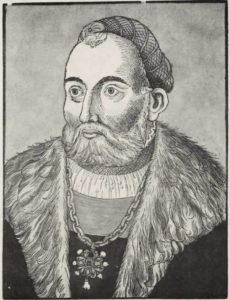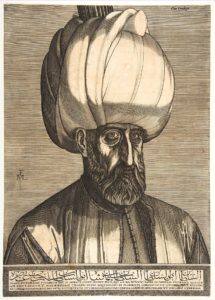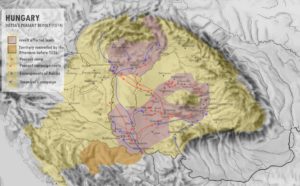1527 Cserni (aka Black or Nenad) Jován’s uprising

A bloody moment took place after the confusion that followed the Battle of Mohács. After Sultan Suleiman left the Hungarian kingdom, the order has soon been established and the country was functioning again. It was due to the efforts of the recently elected and crowned King Szapolyai János who used to be the Voivode of Transylvania, the mightiest oligarch of the kingdom. However, it didn’t help the rebuilding of the country that he had to face with the attack of King Habsburg Ferdinand of Bohemia who wanted the throne for himself. As Ferdinand had also crowned himself with the Hungarian Sacred Crown, Hungary’s bloody period of Dual Kingship commenced.

To make things worse, the European powers offered not much help or acceptance to King Szapolyai. Meanwhile, the country’s southern gates were wide ajar before the next Ottoman invasion. The Ottomans threatened to overrun the divided kingdom at any moment. Thus, King Szapolyai was cornered and had no other choice but to get allied with Sultan Suleiman in 1528, and with his diplomatic move, he was able to keep the Turks out of the country. However, there had been a very bad internal war that just quickened him to ally himself with the Sultan because this war made his situation even more unstable.

Right after the Turks’ departure in 1526, Szapolyai wanted to reorganize the southern Military Borderland against the enemy. He appointed his trusted man, the Serbian Cserni (aka Black or Nenad) Jován who had fought in the Battle of Mohács, to organize the Serbians against the Ottoman invaders. (Please, note that I use the Oriental name order for Hungarians where family names come first.)

The conflict between the Serbs and the local Hungarians began in earnest when after the Ottoman peril, the Hungarians returned to their lands. They found Serbs in their homes who took shelter in the abandoned houses. In the meantime, Szapolyai tried to settle the Serbs in Bács County and appointed Jovan, his trusted man as their leader. Jovan was a talented military leader and a physically very strong warrior; he was trying to persuade Szapolyai to attack Habsburg Ferdinand before the Austrian Archduke would launch his inevitable attack against Hungary. Most sadly, King Szapolyai didn’t listen to his clever advice.

Not much later, things turned out very bad: gradually, Cserni Jován (1492-1527) declared himself an independent Czar and he was busy creating his small country in Southern Hungary. A most brutal war was taking shape. Jován was said to be not less violent and brutal than his master, Szapolyai. Let us remember how mercilessly Szapolyai had put the peasant uprising of Dózsa György down in 1514. Later, Szapolyai was not hesitating much to have people impaled, he had even a monk executed like that. Peasants feared and hated him at the same time.

Soon, Jovan claimed that it is „his God-given mission” to drive the Turks out of the country as Dózsa György had claimed so at the beginning of his uprising a decade or so before. Indeed, Jovan was fighting against the Turks during the first phase of his “reign”. Were the manors of local Hungarian lords plundered and burned? Yes, of course. No wonder, that the Hungarian lords of the area didn`t trust him and clashes began.

Jován took the town of Szabadka (Суботица / Subotica) in November 1526 and it caused hostilities as it triggered a conflict with the local lords. The noblemen were upset and attacked the Serbs, and the civil war or uprising was unstoppable. Jovan declared himself the Czar of Serbia, the Banate of Temes, and Bács County. His “royal” court was at Szabadka, he had an army of 15,000 men. He had his own coins minted and gave high courtly titles to his officers. However, many people think these things had been invented only by his enemies. The alienated Hungarian noblemen began to call him a traitor to the Turks. Csáky László tried to scatter his army but Jovan defeated him and had Csáky beheaded. Then, he took Szeged where he set up his new court.

Soon, the Czar’s soldiers killed and destroyed everybody, Hungarians, Wallachians, and Saxons alike. On top of this, Habsburg Ferdinand jumped at the idea of spreading havoc in Szapolyai’s hinterland: he began to support Jovan and instigate him against the Hungarians by sending him lots of money and valuable gifts.

Then, Szapolyai had enough of it and ordered Voivode Perényi to put down the uprising. However, Jován’s power was growing and he defeated the Hungarian-Saxon army of Lord Perényi Péter on 22 May 1527 at Tiszaszőlős, then he began raiding and destroying south Transylvania. They were burning and looting along the Maros River area, and they also destroyed the lands of those who were on the Habsburg king’s side. His men scorched the land until Szászváros (Broos, Orăștie). Read more about the country’s second-wealthiest oligarch, Perényi Péter here:
https://www.hungarianottomanwars.com/essays/lord-perenyi-peter-1502-1548-part-one/
In Transylvania, Jovan’s men killed many Wallachians, Hungarians, and Saxon peasants and burghers. By this time, lots of Serbs had abandoned his army and returned to the Ottoman-conquered lands of Szerémség / Sirmium. Many of these fleeing smaller Serbian units were eliminated one by one. Surprisingly, those Hungarian peasants who had been fighting in Dózsa`s Peasant Uprising in 1514 against Szapolyai, now sided with him to fight the army of Jovan. They flocked under the flags of the very landlords who had so brutally put them down a decade ago. The time has come when King Ferdinand has also quit supporting Jovan. Unfortunately, Szapolyai lost much of his reputation before his supporters because he had not broken up with Jovan soon enough.

Finally, Cserni Jovan and his 8,000 men were defeated in July 1527 by the combined army of Hungarian, Serbian, Wallachian, and Saxon peasants and lords. They were led by Lord Perényi and Bishop Czibak Imre of Várad and the Comes of Temes County, and there were about 13,000 soldiers in their army. The battle took place at Sződfalva, near Szeged. The Serbian army was demoralized and finally suffered a crushing defeat. The “Czar” received a light wound in the battle, and he fled toward Szeged. When he arrived there, he was acting like before, he and his men were looting the settlement. He attacked the house of Zákány István, a local burgher but it was a fortified building, surrounded by a strong and high stone wall. Jovan was shot by a musket fired from a window, and the bullet of a man called Vid Sebestyén injured his loins. Jován’s surviving men rescued him from Szeged and took him to Tornyos. It was where the servants of a high lord called Török Bálint found him.

According to some opinions, it was Török who cut off the wounded (or dead?) Jovan’s head and sent it to Szapolyai, boasting that he had killed him. Szapolyai gave him a large award, then he had a “Te Deum” celebrated for the victory in Buda. After this, he had Jován’s head carried around in the town, then had it cast into the Danube River. However, Török’s lie was soon discovered, and he was so ashamed that he left Szapolyai and took the side of King Ferdinand who was happy to have him. As a result of Jovan’s defeat, thousands of Serbs fled to the Ottoman Empire. Many of Jovan`s men joined the Turkish army and took part in the siege of Vienna. They took revenge on the Hungarians when Suleiman led his troops in the next years. The folks between the Danube and the Tisza River suffered much in that period.

Hundreds of years later, Jovan became a dividing person between Serbs and Hungarians and sadly, it has contributed to many ethnic troubles in the 19th and 20th centuries. Many Serbians, though, remained in either Royal Hungary or Transylvania and continued fighting against the traditional enemy, the Ottoman Empire. It is just too bad that similar conflicts took place after 1699 when the Turks were driven out of the kingdom: the Habsburgs had a hand in triggering those conflicts, too.

Dear Readers, I can only make this content available through small donations or by selling my books or T-shirts.
If you like my writings, please feel free to support me with a coffee here:
You can check out my books on Amazon or Draft2Digital, they are available in hardcover, paperback, or ebook:
https://www.amazon.com/dp/198020490X
or at https://books2read.com/b/boYd81


My work can also be followed and supported on Patreon: Become a Patron!http://Become a Patron!


